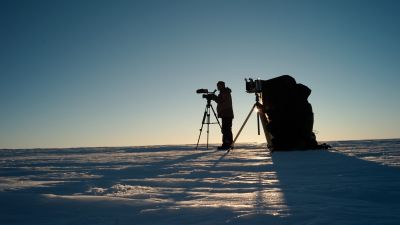
Drilling for Answers in Antarctica: The IceCon & Be:Wise Projects
Photographs just in from Antarctica - our field team has journeyed 254km away from Princess Elisabeth Antarctica, for the IceCon and Be:Wise projects, both of which are investigating the movement of Antarctica's ice cap - and the implications. IceCon aims to gain a better understanding of the rate of the loss of ice – now and in the past - from the Antarctic ice sheet in the Dronning Maud Land area. The Be:Wise project aims to improve understanding of ice-shelf flow dynamics by focusing on the buttressing role of ice rises and pinning points – small offshore mountains which support Antarctic ice shelves from underneath.
-
Morgane Philippe and Jean-Louis Tison checking the new drilling equipment used by the Icecon scientific team at the Field Camp.
© International Polar Foundation
-
IceCon and Be:Wise traverse convoy heading to the coast from Princess Elisabeth Antarctica, - it takes 23h to complete the 254km.
© International Polar Foundation
-
Field guide Raphael Richard planting flags along the way to mark a safe route for the convoys from Princess Elisabeth Antarctica to the IceCon and Be:Wise field camp.
© International Polar Foundation
-
Glaciologists Jean-Louis Tison and Bryn Hubbard carrying our drilling operations on Antarctica's Derwael Ice Rise, as part of the IceCon project, based at Princess Elisabeth Antarctica during November-December 2012.
© International Polar Foundation
-
A view into an IceCon drilling hole -the top of the drill is visible.
© International Polar Foundation
-
Convoy departs for the Be:Wise scientific project.
© International Polar Foundation
-
Glaciologist and InBev-Baillet Latour Antarctic Fellowship recipient Reinhard Drews installing a GPS station on the Roi Baudoin ice shelf as part of the Be:Wise scientific project.
© International Polar Foundation
-
Glaciologists Morgane Philippe and Bryn Hubbard measuring ice core length and taking temperature measurements for the Icecon scientific project, based at Princess Elisabeth Antarctica during November-December 2012.
© International Polar Foundation
-
Permanent GPS Station placed on the Derwael Ice Rise for the IceCon project.
© International Polar Foundation
-
The IceCon team "hot-drilling" into the Derwael Ice Rise in Antarctica, as part of the "coffee can" method to work out movement of the ice sheet.
© International Polar Foundation
-
Skidoo Passing between two walls of ice near the coast of Antarctica
© International Polar Foundation
-
A Skidoo negotiates difficult ice conditions to get to reach the Antarctic coast.
© International Polar Foundation
-
Emperor penguins gliding on the ice. This penguin colony of about 9000 individuals is situated about 50km from the Derwael Ice Rise.
© International Polar Foundation
-
The colony was detected by satellite via fecal stains survey conducted by British Antarctic Survey, National Environment Research Council in 2009.
© International Polar Foundation
-
Emperor penguins: adults and chick. This penguin colony of about 9000 individuals is situated at about 50km of Derwael ice rise.
© International Polar Foundation
-
A closer view at the penguin colony.
© International Polar Foundation
-
Field guide Raphael Richard, drilling 15 meters into the ice to take samples for measuring snow density, during the IceCon field work.
© International Polar Foundation
-
Scientist Kenichi Matsuoka, of the Norwegian Polar Institute saving radar data on his toughbook for the IceCon project.
© International Polar Foundation


















